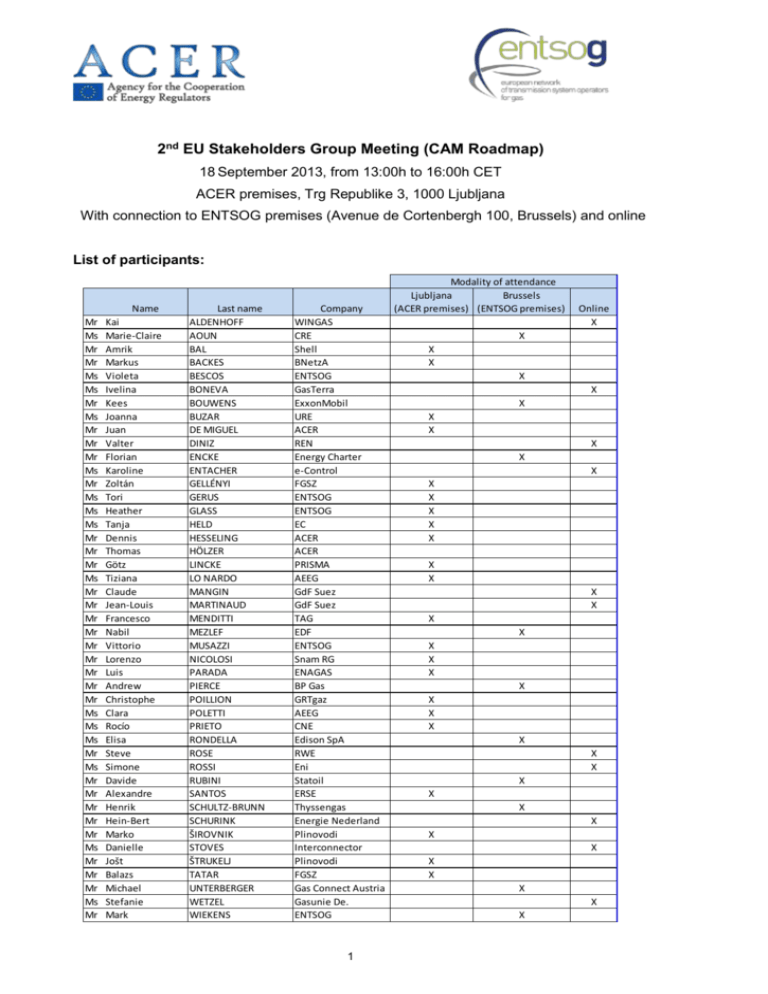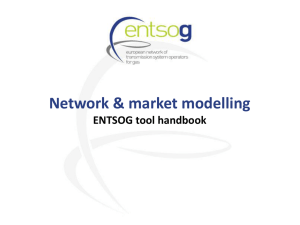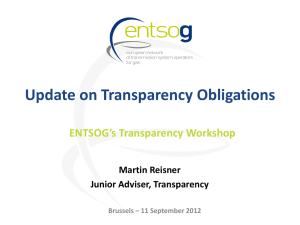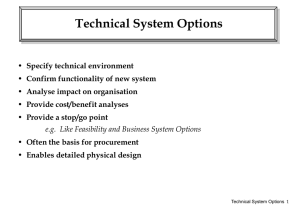2nd EU Stakeholders Group Meeting 18-Sep-13
advertisement

2nd EU Stakeholders Group Meeting (CAM Roadmap) 18 September 2013, from 13:00h to 16:00h CET ACER premises, Trg Republike 3, 1000 Ljubljana With connection to ENTSOG premises (Avenue de Cortenbergh 100, Brussels) and online List of participants: Mr Ms Mr Mr Ms Ms Mr Ms Mr Mr Mr Ms Mr Ms Ms Ms Mr Mr Mr Ms Mr Mr Mr Mr Mr Mr Mr Mr Mr Ms Ms Ms Mr Ms Mr Mr Mr Mr Mr Ms Mr Mr Mr Ms Mr Name Kai Marie-Claire Amrik Markus Violeta Ivelina Kees Joanna Juan Valter Florian Karoline Zoltán Tori Heather Tanja Dennis Thomas Götz Tiziana Claude Jean-Louis Francesco Nabil Vittorio Lorenzo Luis Andrew Christophe Clara Rocío Elisa Steve Simone Davide Alexandre Henrik Hein-Bert Marko Danielle Jošt Balazs Michael Stefanie Mark Last name ALDENHOFF AOUN BAL BACKES BESCOS BONEVA BOUWENS BUZAR DE MIGUEL DINIZ ENCKE ENTACHER GELLÉNYI GERUS GLASS HELD HESSELING HÖLZER LINCKE LO NARDO MANGIN MARTINAUD MENDITTI MEZLEF MUSAZZI NICOLOSI PARADA PIERCE POILLION POLETTI PRIETO RONDELLA ROSE ROSSI RUBINI SANTOS SCHULTZ-BRUNN SCHURINK ŠIROVNIK STOVES ŠTRUKELJ TATAR UNTERBERGER WETZEL WIEKENS Company WINGAS CRE Shell BNetzA ENTSOG GasTerra ExxonMobil URE ACER REN Energy Charter e-Control FGSZ ENTSOG ENTSOG EC ACER ACER PRISMA AEEG GdF Suez GdF Suez TAG EDF ENTSOG Snam RG ENAGAS BP Gas GRTgaz AEEG CNE Edison SpA RWE Eni Statoil ERSE Thyssengas Energie Nederland Plinovodi Interconnector Plinovodi FGSZ Gas Connect Austria Gasunie De. ENTSOG 1 Modality of attendance Ljubljana Brussels (ACER premises) (ENTSOG premises) Online X X X X X X X X X X X X X X X X X X X X X X X X X X X X X X X X X X X X X X X X X X X X All presentations made at this meeting can be found at: http://www.acer.europa.eu/Gas/Regional_%20Intiatives/CAM_roadmap/2nd_EU_Stakeh olders_Group_meeting/default.aspx http://www.entsog.eu/publications/capacity-allocation-cam#2-CAM-NC-EARLYIMPLEMENTATION-DOCUMENTS-AND-MEETINGS 1. Opening and welcome Ms Poletti (ACER) and Mr Musazzi (ENTSOG) welcomed all participants to the second meeting of the CAM Roadmap EU Stakeholders Group, aiming at (i) presenting the progress made by the CAM pilot projects that are part of the CAM Roadmap and (ii) promoting transparency in the process of early implementation of the Network Code on Capacity Allocation Mechanisms (CAM NC) towards stakeholders. 1.1. Agenda and objective of the meeting No comments were made on the agenda and therefore it was approved. 1.2. Brief introduction of participants All participants in the meeting – respectively at ACER premises in Ljubljana, at ENTSOG premises in Brussels or online – briefly introduced themselves and some practical instructions regarding online participation were provided by ACER. 2. Update of the projects on early implementation of CAM 2.1. PRISMA Mr Poillion (GRTgaz) gave a presentation on the current state of implementation of the PRISMA platform and on the main aggregated results of the project since it was launched in terms of participants, number of auctions run, products offered, platform functionalities and capacity allocated. Mr Poillion described the experience developed so far as “a success story”, with no significant problems encountered to date. He announced that in the near future new TSOs – such as National Grid, Gaslink, REN, TIGF, GAZ-SYSTEM and Enagas – are expected to join the platform and new functionalities will be offered, concerning secondary capacity allocation, multi-currency trading and within-day allocation. More detailed data on the capacity allocation results of the platform over the first year of operation will be presented at the next meeting. 2.2. Bundled Product at Lasów Ms Glass (ENTSOG) presented the main developments of the pilot project at the Lasów IP on behalf of the TSOs involved (GAZ-SYSTEM and Ontras). She described the timeline followed so far and planned until spring 2014, the capacity offered and allocated in the first auctions for the first three quarters of 2014, the next steps of the project and the products that are envisaged to be offered for the upcoming quarters and years. The intention of the TSOs is to allocate all types of CAM NC compliant products before the mandatory deadline for the implementation of such network code (November 2015). Mr Lincke (PRISMA) reported that a key learning arising from this project is that TSOs were able to join the platform with no delay and several shippers were able to enter the Polish market through it (around 15 companies joined PRISMA because of this project). 2 2.3. Bundled Product and Capacity Platform – Hungary/Romania Mr Gellényi made a presentation on the latest developments and the state of play of the pilot project and regional booking platform (RBP) between Hungary and Romania. The initial plan was to start auctions in September 2013 but due to organisational changes concerning the parties involved a delay has occurred. The project roadmap has been adapted accordingly. The final date for the entry into operation of the platform will depend on the successful resolution of the outstanding legal and regulatory issues. The date of the first auctions is expected to be 18 November 2013. Monthly products are intended to be auctioned first. Afterwards, the pilot project could be extended to products of different duration, firm and interruptible reverse flow capacities and capacity at other IPs or with other TSOs. FGSZ and Transgaz are considering increases of reverse flow capacities up to 200 kcm/h, if the Open Season procedure to be conducted in early 2014 will be successful. FGSZ outlined the project’s approach on a number of issues of interest, such as the harmonisation of capacity products, CAM-CMP interaction and instant access to the RBP platform by shippers, together with some outstanding areas for further work. 2.4. South CAM Roadmap: Annual Transmission Capacity Auction at the VIP between Portugal and Spain and coordinated allocation of bundled capacity for the whole South region (France-Spain-Portugal) Ms Prieto (CNE) presented the main features and current state of play of the South CAM Roadmap, involving Spain, Portugal and also France, which joined the project this year. The project started in 2012 with coordinated auctions of annual and monthly bundled products between Spain and Portugal and continued this year with auctions of annual and quarterly products. In 2014, auctions will be carried out at all interconnections in the South region. The experience developed so far has been quite positive in terms of cooperation between NRAs and TSOs and has allowed the parties involved to harmonise and agree upon a number of aspects related to capacity allocation in the region. The harmonisation of other aspects such as the gas day, nominations and units used will follow. TSOs are now working to develop their IT systems and with the aim to offer as much bundled capacity as possible at the VIP. The four TSOs in the region are either already participating in PRISMA (GRTgaz), or have the intention to do it in the future via a pilot project (Enagas and TIGF), or are working towards that target (REN). Ms Prieto presented the envisaged calendar for the auctions planned in 2014 at the different IPs between the TSOs in the region. In France, the merger of the current three balancing zones into a single one is progressively taking place in view of its completion by 2018 and capacity products are being adapted to the CAM NC requirements. At the IP between GRTgaz North and South, the current allocation system (prorata mechanism) will be kept to allocate a 6-month product (1 April - 30 September 2014) in order to adapt the products with the CAM calendar. In March 2014, annual capacities up to 30 September 2018 will be commercialised within a combined system for capacity allocation of auctions and pro-rata. Ms Held (EC) questioned the use of the pro-rata method planned to be applied until 2018, since this is not compliant with the CAM NC which will become legally binding as of November 2015. Ms Aoun (CRE) explained that CAM needs to be implemented progressively at this IP by November 2015, due to the balancing zones merging process and the strong physical congestion existing at the link between GRTgaz North and South. Discussions on this matter are ongoing at national and regional level and a public consultation has recently been run by CRE. The final decision is not taken yet and is 3 expected for October. Enagas informed that they have participated in the public consultation on the mentioned topic and stressed that once the CAM NC applies there should not be discrimination among users, in particular in favour of those who have already booked capacity at other facilities, or that have certain consumption profiles. Finally, CNE explained that they still need to assess the potential impact on the electricity sector of the change of the gas day from 0h to 24h to 6h to 6h. They might need to change many aspects of the national network codes and also the current IT systems, due to the strong link with the balancing process. 3. Overview of implementation in Europe (IP list) 3.1. Overview of early implementation in Europe (IP list) Ms Gerus (ENTSOG) presented to all participants one of the significant developments in the updated version of the CAM Roadmap that will be published in October and presented at the next Madrid Forum, namely, the new Annex 2 containing information on CAM early implementation per interconnection point (IP). The table in this annex, which builds upon the IP list jointly developed by ENTSOG and ACER following the CAM NC comitology process, contains information provided by TSOs during August 2013 in reply to a request for information from ENTSOG on several aspects related to the CAM NC implementation. These aspects concern (i) the products of different duration (yearly, quarterly, monthly, day-ahead and within-day) offered at each IP, and whether or not bundled products are already offered; (ii) the use of a webbased platform and the link to the relevant website; and (iii) the use of the CAM NC timings and auction algorithms. For each IP, it is indicated whether the feature is already implemented or the expected timetable for its implementation (end 2013, end 2014, prior to the implementation deadline of 1 November 2015 or on this date). There is also an indication of possible differences in the implementation of the respective CAM provisions by the TSOs at both sides of the IP. Several examples on the way information is presented in the table were illustrated by ENTSOG. It was noted that standard products are being introduced progressively and bundling is at a nascent stage but will increase over time. The table currently covers only those IPs where implementation is expected at both sides of the border, but ENTSOG and ACER expressed their ambition to see an increase of the number of IPs reported in the next update of the CAM Roadmap. This IP list is meant to be a valuable resource for stakeholders and may be made available to stakeholders not only in PDF format (as currently uploaded in ENTSOG website) but also in a more workable format (Excel) on demand. ENTSOG will welcome any feedback to the list by e-mail. Ms Poletti stressed the importance of the work done and congratulated ENTSOG for it. ACER and ENTSOG agreed that this first version of the list gives a good overview on how early implementation is advancing and spreading across different borders and IPs in Europe. 3.2. Issues arising in the CAM NC early implementation: review of solutions adopted and open questions Ms Poletti presented the second main development in the new version of the CAM Roadmap, namely, the overview of issues, solutions adopted and open questions identified in the CAM NC early implementation process, included in the new section 4.5 of the Roadmap. The issues and open questions addressed under this point were the following: 4 Definition of price steps Art. 17 of the CAM NC does not specify the ratio between the large and small price steps (how many small price steps are included in a large price step). Operational discretion is left to TSOs and booking platform operators to decide on that ratio. At the meeting, several experiences were shared with participants: • PRISMA is applying the ratio already used in Germany (1/5 for small/large price steps). The number of price steps is not limited. • At the Spain-Portugal VIP, price steps are defined on the basis of a proportional incremental premium equal to 3% (arithmetic progression) of the tariff in each country with 30 price steps per Member State. • RBP (HU/RO) enables any LPS/SPS ratio, provided that the LPS is an integer number multiple of the SPS. The ratio can be set up before each individual auction by TSOs. If TSOs do not set a value, the default ratio is 1:10. Auction premium and split and destination of auction revenues In Article 26 of the CAM NC, the split of the revenues above the reserve price is left to the agreement between TSOs and to the approval by NRAs. In the absence of an agreement, a default rule of equal split (50:50) applies. Regarding the destination of congestion revenues, or auction premium, Chapter 4 of the Tariffs FG addresses this issue. The examples reported at the meeting were the following: • At the IPs where capacity is allocated via PRISMA, the default rule (50:50 split of the auction premium) is applied, unless otherwise justified on a case-by-case basis and approved by the relevant NRA, if necessary. • At the Spain-Portugal VIP, the default rule is also applied. • In RBP (HU/RO), TSOs can set any auction split. FGSZ and Transgaz chose the proportional split according to their respective currencies. Mr Gellényi (FGSZ) explained that the bids are submitted as a percentage of the reserve price (as consulted and approved by NRAs). The issue is “who bears the currency risk”. Payments are done in the two respective currencies. Interrelation between CAM and CMP Several CAM NC provisions have interactions with some of the requirements from the CMP Guidelines. The application of these provisions from the CAM NC and the CMP Guidelines has to take place in a compatible and consistent way. The concurrent implementation of the CMP Guidelines and CAM NC requirements and potential coordination issues are analysed in a document developed by ACER in spring 2013 which is now published on the ACER website1. Bundling of different firm capacity products The amount of capacity that can be bundled at each IP is sometimes limited due to the existence of asymmetric available capacity at both sides of the IP. In case of 1 http://www.acer.europa.eu/Official_documents/Acts_of_the_Agency/Publication/ACER_CMP_Gui dance issue paper on CMP implementation_20130808.pdf 5 different firm capacity products at each side of the IP, rules to allow for effective bundling may be required. Some examples were presented on this matter: • On PRISMA, two bundling approaches are possible: classic bundling and cross bundling. The classic bundling approach is done “offline” by the TSOs, who submit bundled or unbundled products which cannot be changed by the platform. TSOs have to coordinate “offline” especially regarding day-ahead products. The cross bundling approach is done “online/automatically” by the platform, in a sequential manner according to a priority order where products of different types or “flavors” exist at one side of the border. • RBP applies the same-quality bundling which takes place online on the platform. Different currencies in use at each side of the border When TSOs allocate capacity at IPs where a different currency is used at each side of the border operational challenges may arise. The experiences shared at the meeting on this topic were the following: • In the HU/RO project, TSOs keep the reserve price in both currencies and execute the bids as a percentage of the reserve prices. • In the PL/DE project at Lasów IP, one currency was selected for the bids. The applicable exchange rate is the same as that applied at the moment of the completion of auctions. • In PRISMA, only the Danish TSO uses a currency different from the euro. No currency conversion mechanism is implemented on the platform itself. Energinet.dk is responsible for converting Danish kroners into euros (and vice versa). Countries with different time zones Potential issues might arise when TSOs allocate capacity at IPs where the time zones are different at both sides of the border. This is why this topic was also identified as a potential issue to be tackled. However, the issue has been addressed bilaterally in a successful way wherever it has appeared. Given that the standard gas day is now defined (Article 3 “Definitions” of the CAM NC), this should not be an issue for CAM early implementation projects in the future. A particular example was shown by FGSZ. The Regional Booking Platform applies the UTC time standard which solves the issue both for Network Users (bidding from different time zones) and TSOs (being in different time zones). Licensing issues The different requirements in terms of licenses for the users to operate in different countries might create an obstacle when accessing bundled capacity at certain IPs. The issue had been identified in different countries prior to the meeting: • Energy shippers in Hungary and some other Central-Eastern European Member States are required to obtain a license to trade gas at wholesale level, whose criteria may differ from Member State to Member State. The need for crossborder licensing is being addressed in discussion with NRAs. 6 • In France, all network users are required to obtain a license from the government which enables them to sign a transmission contract with GRTgaz and/or TIGF. It is not, however, the task of the TSO to check the validity of the license. It was clarified that, according to the discussion held at the CAM Coordination meeting in the morning, this remains an open issue still to be tackled, and therefore it will be kept on the agenda for future meetings. Costs of booking platforms The establishment and use of joint web-based booking platforms involves capital and operational expenditure to be incurred by TSOs. How such fixed and variable costs are shared across TSOs and whether they are recognised as ‘efficiently incurred’ by the relevant NRAs remains an open question in some Member States. Activities of joint platforms and need for appropriate exchange of information TSOs should ensure that CAM implementation activities via joint platforms are transparent to the market and NRAs, allowing appropriate exchange of information. Harmonisation of the capacity contracts at both sides of the border The implementation of the CAM NC will result in the harmonisation of certain aspects of capacity contracts. Further harmonisation of contractual terms will result when other NCs are implemented (e.g. balancing NC for nominations). The appropriate degree of harmonisation of these contracts remains an open question. Ms Poletti asked stakeholders if in their view this was a realistic and comprehensive overview of issues or whether there would be any other issue to report or add to the list. She also asked for feedback about the importance of the issues presented and whether a priority order could be established. Mr Rubini (Statoil) reported on IT-related problems currently existing in the UK. The change to the gas day driven by the CAM NC has a wide range of practical implications which in some cases (for example when considering metering at offshore production facilities) will be time consuming and expensive to resolve. The main concern is that some shippers may be facing more challenges than others. Mr Pierce (BP) indicated that, in BP’s view, market participants (at least in the UK) are worried that the application of the CAM NC provisions may require amendments to the existing contracts which, in turn, could trigger further changes to those contracts in the future. Mr Mezlef (EdF) stated that the two major issues among those discussed were the relationship between CAM and CMP and the bundling of different firm capacity products. Ms Rondella (Edison) asked if the potential harmonisation of contracts would include shippers’ guarantees. Ms Poletti replied that it could potentially include every aspect covered in the contracts but that the scope of this harmonisation still has to be agreed. 3.3. CMP implementation: update on progress Ms Aoun made a presentation on the state of play of CMP implementation across the different EU Member States, with respect to each one of the CMP mechanisms established in the CMP Guidelines applicable as of 1 October 2013. Additional clarifications on how CMP mechanisms are planned to be applied in the different countries were provided. 7 As a conclusion, it was noted that NRAs’ replies to the questionnaires circulated by ACER show that the decision on the implementation of CMP provisions is still pending in some cases. The EC stated that it is very important that the approach to CMP implementation in EU Member States is as consistent and harmonised as possible. It was asked whether there will be any distinction between buy-back capacity and capacity released from short-term UIOLI. Several shippers also asked about the implications of the use of two different CMP methods at the two sides of the same IP. Finally, further difficulties might arise if TSOs have to deal with nominations of different values at both sides of a border. Mr Backes (BNetzA) reminded some of the solutions recommended by ACER in its paper on the need for coordinated decisions at EU level for the implementation of the CMP guidelines, which provides non-binding guidance on CMP implementation to NRAs. In particular, regarding the difficulties arising from the existence of different nominations at the two sides of an IP, he indicated that a single nomination will put a remedy to that. 3.4. Article 27 CAM NC – ENTSOG Booking Platform Report (BPR) project Ms Gerus presented the project plan, envisaged timing and planned working arrangements in view of preparing the booking platforms report (BPR) that ENTSOG has to produce according to article 27 of the CAM NC. Within six months after the entry into force of the NC, ENTSOG has to launch a public consultation to identify the market needs. This consultation shall not last more than six months and within this time period ENTSOG will have to publish a report with its results. The report shall identify options to implement the indicated market needs, having regard to costs and time, with a view to implement the most appropriate option. ENTSOG and ACER are called to facilitate the process. Ms Gerus presented the detailed steps of the envisaged process within the timetable established by the NC. ENTSOG plans to set up two work streams: an external group with participation from stakeholders in view of the public consultation on market needs, and an internal group in ENTSOG for analysing the cost and time aspects referred to in article 27 of the NC. ENTSOG called for participants volunteering to join the first group. 4. Q&A session No further questions were raised under this point, in addition to the ones already made under the previous points of the agenda. Ms Poletti informed all participants that the new version of the CAM Roadmap containing the updated information presented at the meeting will be published in the following weeks and presented at the next Madrid Forum in October. 5. Next meeting The next meeting will take place in Brussels in 2014. The exact date and schedule will be communicated in due time. 8









